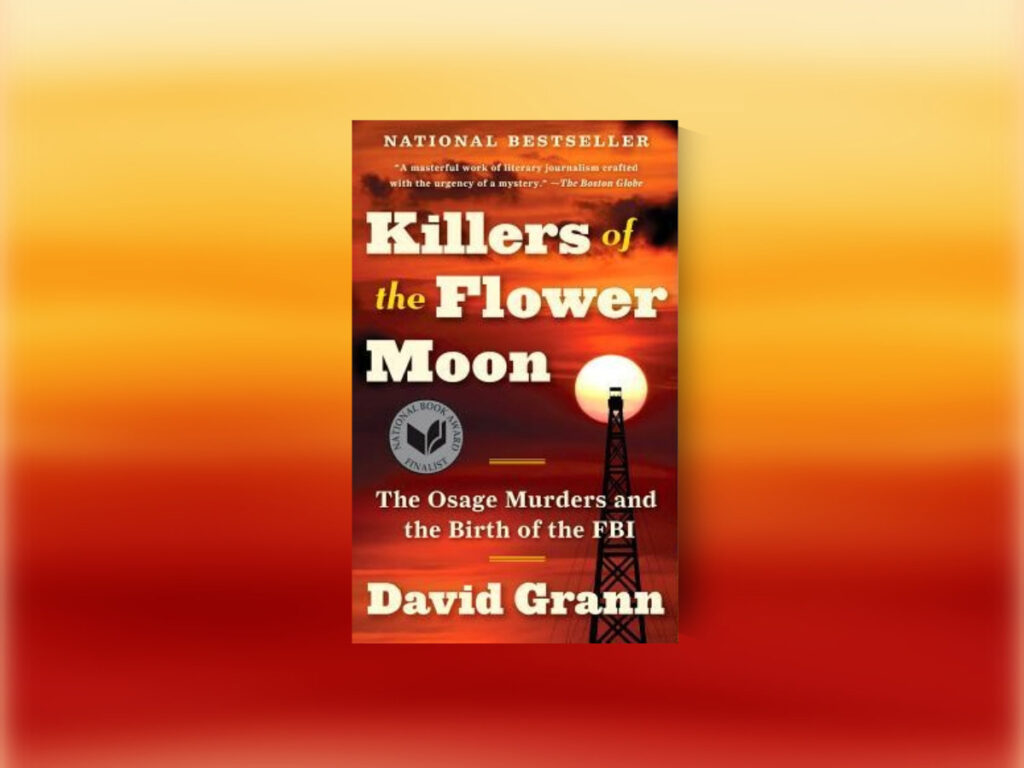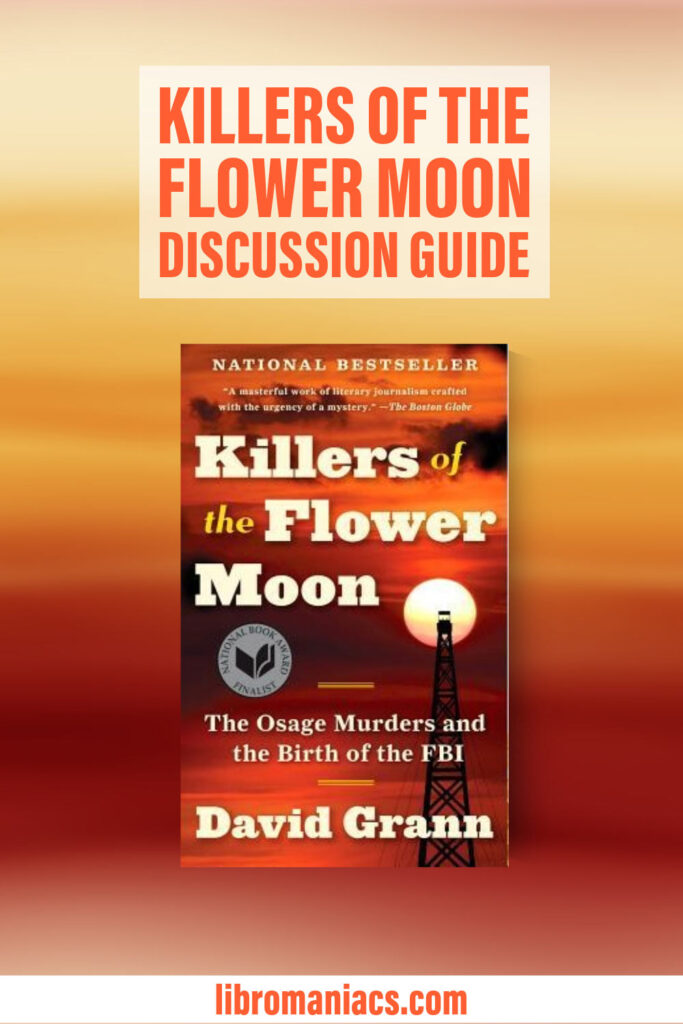The people of the Osage Nation in Oklahoma went through a turbulent time in the early 1900’s, experiencing displacement, extreme wealth, and unexplainable deaths. In the Killers of the Flower Moon: The Osage Murders and the Birth of the FBI, David Grann delves into the story of the Osage people and how their fates were intertwined with the beginnings of the FBI. Recently developed into a star studded movie, this story is rich with topics for book club discussion and we have some Killers of the Flower Moon book club questions to help you get there.
This Killers of the Flower Moon discussion guide has everything your book club needs to delve into this intense part of American history. Explore the founding of the FBI, law enforcement development, the oppression of the Osage people, unexplained murders, vast oil wealth, and more with our Killers of the Flower Moon book club discussion questions.
Also included in the discussion guide are a synopsis, selected reviews from other readers, and some ideas for related reads. This discussion guide has everything you need to get the most out of this powerful book about a devastating and important part of American history.

(This article contains affiliate links. This means that if you choose to purchase, I’ll make a small commission.)
Killers of the Flower Moon Synopsis
(We always chose to provide the publisher synopsis because we feel that it’s worthwhile to discuss whether the official book description actually squared with your experience of the book.)
Killers of the Flower Moon, David Grann
(Subtitle: The Osage Murders and the Birth of the FBI)
In the 1920s, the richest people per capita in the world were members of the Osage Nation in Oklahoma. After oil was discovered beneath their land, the Osage rode in chauffeured automobiles, built mansions, and sent their children to study in Europe.
Then, one by one, the Osage began to be killed off. The family of an Osage woman, Mollie Burkhart, became a prime target. One of her relatives was shot. Another was poisoned. And it was just the beginning, as more and more Osage were dying under mysterious circumstances, and many of those who dared to investigate the killings were themselves murdered.
As the death toll rose, the newly created FBI took up the case, and the young director, J. Edgar Hoover, turned to a former Texas Ranger named Tom White to try to unravel the mystery. White put together an undercover team, including a Native American agent who infiltrated the region, and together with the Osage began to expose one of the most chilling conspiracies in American history.
10 Killers of the Flower Moon Book Club Questions
These questions have been tailored to this book’s specific reading experience, but if you want more ideas, we also have an article with 101 generic book club questions.
- Before reading this book, had you heard about the Osage Nation, their oil wealth, and the mysterious murders? How did this book expand your knowledge of these events?
- “Some day this oil will go and there will be no more fat checks every few months from the Great White Father,” a Chief of the Osage said in 1928. “There’ll be no fine motorcars and new clothes. Then I know my people will be happier.”
What do you think about what this Chief said? Do you think they are happier without the wealth?
- What do you think about how the media portrayed the Osage and their wealth? How do you think it influenced the general public’s view of the tribe?
- “Only in the mid-nineteenth century, after the growth of industrial cities and a rash of urban riots—after dread of the so-called dangerous classes surpassed dread of the state—did police departments emerge in the United States.”
What do you think about how law enforcement was viewed during this time, and how they handled crimes like murders? What is better or worse about law enforcement now?
- Do you think it is possible for something like this to happen now? Why or why not?
- “At forty-four, Mollie could finally spend her money as she pleased, and was recognized as a full-fledged American citizen.”
What do you think about the financial guardians who were assigned to the Osage people?
- “As she spoke, I realized that the Reign of Terror had ravaged – still ravaged – generations. A great-grandson of Henry Roan’s once spoke of the legacy of the murders: ‘I think somewhere it is in the back of our minds. We may not realize it, but it is there, especially if it was a family member that was killed. You just have it in the back of your head that you don’t trust anybody.’”
What do you think the ongoing legacy of these murders is? How will it affect further generations? Is there anything that can help?
- There are so many outrages in this story, what made you the most mad?
- What do you think about the breathtaking betrayal and loss Mollie experienced?
- What do you think about the portrayal of Hoover, and how he shaped the FBI?
- BONUS: If you have seen the movie adaptation, what did you think? What was portrayed differently? Was anything left out?
Selected Reviews for Killers of the Flower Moon
(Use these selected Goodreads reviews to compare with your own experience of the book. Do you agree or disagree with the reviews?)
“My main criticism is that while the story is interesting, I am not quite sure it is book worthy. It seems like this whole story could have been told in 30 to 50 pages or in a Wikipedia article. […] Also, the title of this book would indicate that there is a lot of detail about the formation of the FBI – I don’t really feel this was the case. There were a few pages about how local law enforcement was too corrupt so they needed the federal government involved, but that was about it. Some may disagree, but I hardly felt that this book could be used for a history report on the start of the FBI.”
“Although I was aware of the general horrific treatment of the indigenous people by the white man, I am shocked and shattered to learn of the special hell the Osage people were subjected to.
Because this history was so well-hidden, thorough and proper research was required. Mr. Grann was quite clearly the perfect person, as he uncovered and articulated multiple conspiracies. Although his affection and admiration of the Osage is evident, he miraculously manages to convey their circumstances in an objective, rather than angry voice.”
“Let there be no doubt: This was one of the myriad forms of genocide visited by the white man on American Indians. Were the Nazis much different in their ultimate intent? Perhaps more systematic but the impetus was the same: expropriate and exterminate. The book is an object lesson in concise storytelling. It contains nothing superfluous. It’s a stunning port-wine reduction of a tale. Grann has learned his lessons well from Truman Capote (In Cold Blood) and Norman Mailer (The Executioner’s Song) and has matched them exquisitely. A superb nonfiction novel. The short, compulsively readable chapters actually give one the sense of hurtling through the narrative.”
“This is the true measure and worth of a great work of nonfiction: What does it uncover? What public service has it served? And has the truth finally been revealed? In a case like the Reign of Terror for the Osage Indians, this book is invaluable to all Americans. Grann has given a voice to the dead—murdered actually—those who were killed for greed, racism, and malice and their families who have suffered for nearly a century left wondering what happened […] There is only one indispensable thing in the world and that is truth. Sometimes the truth is ugly, unbearable, and heartbreaking. That is the truth that we need to understand the most.”
Books Like Killers of the Flower Moon
If you book group likes documentary style non-fiction have a look at The Doctors Blackwell, who were the first women in the US to go the medical school. Or Caste by Isabel Wilkerson which deals with the fine distinctions between race, caste and class.
Yellow Bird, Sierra Crane Murdoch
(Subtitle: Oil, Murder, and a Woman’s Search for Justice in Indian Country)
In this true story, reporter Sierra Crane Murdock follows the story of Lissa Yellow Bird after she is released from prison and returns to her home on the Fort Berthold Indian Reservation in North Dakota. Lissa finds her home deeply altered from the Bakken oil boom, and becomes consumed with finding out what happened to a young white oil worker, Kristopher “KC” Clarke who mysteriously disappeared. Murdock follows her investigation, while also exploring Lissa’s own complex life and history on the reservation.
The Night Watchman, Louise Erdrich
This fictional story brings us into the world of the Turtle Mountain Reservation in North Dakota. Following several different members of the tribe, Erdrich explores the lives of tribe members as they deal with the difficulties on the reservation, oppression, poverty, but also the best qualities of their culture and relationships. The characters fight to protect their land, their families, and preserve their culture and futures.
Read it for book club and use our The Night Watchman discussion guide.
The Devil in the White City, Erik Larson
(Subtitle: Murder, Magic, and Madness at the Fair That Changed America)
If you are interested in reading more historical true crime, this is a great choice. Set in the 1890’s, Larson explores the events surrounding the building of the Chicago’s World’s Fair, a tremendous undertaking at the time. Simultaneously, he reveals the sinister actions of Dr. Holmes, a serial killer in the area who used the attraction of the World’s Fair to lure in his victims. The book weaves the two stories together to draw a compelling portrait of the time and place.
Share these Killers of the Flower Moon book club questions with your friends:




